Text
I’m finally writing again.
Title: Sable Coats and Razorblades (On AO3)
Fandom: All About Eve
Rating: Explicit
Chapters: 5/?
Characters: Addison DeWitt, Karen Richards, Eve Harrington
Pairings: Addison DeWitt/ Karen Richards, Addison DeWitt/Eve Harrington
Warnings: Blackmail, Non-consensual kissing, Dubious consent, Coercion, Dominance/submission, Forced marriage, Marriage of Convenience
Summary: To try to fight Addison DeWitt is doomed to failure, but what if one folds?
#fanfic#fanfiction#all about eve fanfic#all about eve#karen richards#addison dewitt/karen richards#addison dewitt#eve harrington
0 notes
Text
Always fun to see what other people think of my favourite book!
Review: "The Historian" by Elizabeth Kostova

Published: 2005 Page Count: 704
Late one night, exploring her father’s library, a young woman finds an ancient book and a cache of yellowing letters addressed ominously to ‘My dear and unfortunate successor’. Her discovery plunges her into a world she never dreamed of – a labyrinth where the secrets of her father’s past and her mother’s mysterious fate connect to an evil hidden in the depths of history.
Date Started: 26 September 2024 Date Finished: 15 October 2024
The Historian is like if Indiana Jones met Dracula. Historians and Anthropologists exploring eastern Europe and encountering danger- both human and supernatural- in their hunt for artifacts and the truth hidden in tales of folklore.
While the framing of the novel is from the perspective of an unnamed narrator, the bulk of the story follows her father, Paul, in his youth. After the disappearance of his friend and advisor Professor Rossi, Paul teams up with fellow graduate student Helena to find him.
After reading through notes and letters left to him by Rossi, Paul suspects that Dracula- Vlad Tepes of 15th century Wallachia- is responsible for the disappearance.
His journey with Helen to find Rossi brings them to temples and catacombs and has them cross paths with secret societies and vampires alike.
Overall, this is a well-paced book that doesn't rush to get where it's going. The characters make discoveries in a way that isn't overwhelmingly fast or unrealistic. They use the resources available to them and often times are relying only on their quick wits and silver tongues to escape danger.
For me personally, my only grievence with the book is that some passages are written as academic papers, which can be a bit of a slog to get through. I know this was done purposefully by the author, but it did at times make me feel like I was back in college pulling an all-nighter to get through my readings for class.
The book is also very long. It's the longest book I've read in 2024. Especially towards the end of my time reading it there were moments where my motivation to continue was less so the story being told and more so just the desire to finish the book.
Much like Bram Stoker's Dracula, Elizabeth Kostova's The Historian is more or less and epistolary novel. The bulk of the story is not our protagonist retelling events, but copying over events from letters, journal entries, and postcards.
Also like Stoker's Dracula, romance and friendship play huge roles in the narrative. While there is no trio of suitors brought together to defeat a vampire in honor of the woman they love, the main motivation behind most actions the characters take is love- be it romantic, familial, or platonic.
While many books promote themselves as being modern takes on Dracula or savvy retellings of Stoker's novel, in an emotional and spiritual sense, The Historian is in my opinion the definitive new take on Dracula.
I recommend this book to anyone who enjoyed reading Bram Stoker's Dracula, has an interest in history, or enjoys mysteries and romances.
"As a historian, I have learned that, in fact, not everyone who reaches back into history can survive it. And it is not only reaching back that endangers us; sometimes history itself reaches inexorably forward for us with its shadowy claws."
4 notes
·
View notes
Text
I’m rewatching Grimm and actually likes it better than the first time around. And I loved it back then. I love how the characters personal relationship evolves. I still find Sean Renard very hit. And the set design us simply amazing. I feel this show is very unfairly forgotten.








27 notes
·
View notes
Text
Reblog if you’re 30 or older
This is an experiment to see if there really are as few of us as people think.You can also use this to freak out your followers who think you’re 25 or something. Yay!
161K notes
·
View notes
Text
The Historian, Chapter 4
For all his attention to my historical education, my father had neglected to tell me this: history's terrible moments were real. I understand now, decades later, that he could never have told me. Only history itself can convince you of such a truth. And once you've seen that truth - really seen it - you can't look away.
Summary: Back home in Amsterdam, n starts to do her own research of Vlad Ţepeş. A kind librarian, a man N feels would be the sort of person she’d like as a grandfather, helps her locate some information about him. Ni is deeply disturbed by what she learns, but that doesn’t stop her from asking Paul to tell her more. He agrees to tell her everything, but that he can’t bear to give her all the information at once.
Some time later Paul takes N with him on a working trip to Milan in Italy, making a detour to visit old friends, Massimo and Giulia. There, No learns that Massimo too knew professor Rossi, and that he disappeared without a trace, never to be seen again. The next day, while sightseeing in Siena, N implores her father to tell her more about Rossi, and Paul reluctantly agrees.
My thoughts: Reading The Historian chapter by chapter, makes me realize why some people find it too slow. I’m a fast reader, so I never noticed before, but if one only reads this book a chapter at the time, well, then some chapters contain very little. In this chapter we really only learn a little bit more about the history of Vlad Ţepeş, and that Rossi disappeared.
One of the fun things with this re-read is that when I look into the places depicted in the books, dragons keep popping up, though they are not mentioned in the book. In Montepulciano, which Paul mentions as an old town, there is a painting of St George and the dragon in a church. And in Siena they visit Palazzo Pubblico, which is located close to Drago, a neighbourhood of Siena which has had the dragon as an emblem since the Middle Ages.

#dracula#the historian#elizabeth kostova#vampire#reading the historian#vampire literature#vlad tepes#dark academia#dracula daily
1 note
·
View note
Text
The Historian, Chapter 4
In Istanbul there is a little-known repository of materials, founded by Sultan Mehmed II, who took the city from the Byzantines in 1453. This archive is mostly odds and ends collected later by the Turks as they were gradually beaten back from the edges of their empire. But it also contains documents from the late fifteenth century, and among them I found some maps that purported to give directions to the Unholy Tomb of a Turk-slayer, who I thought might be Vlad Dracula. There were three maps, actually, graduated in scale to show the same region in greater and greater detail.
Summary: Paul continues to narrate Rossi’s story, and that Rossi found out in Istanbul that Dracula is still alive. While doing summer research in Crete, Rossi makes a detour to Istanbul, and finds three maps. They don’t resemble Lake Snagov, where Dracula is officially entombed, and at the place the tomb is located, a small dragon is depicted, and underneath the legend 'In this spot, he is housed in evil. Reader, unbury him with a word.
Rossi reads them out aloud, and in the same instant a door slams, footsteps are heard, and a man, who is not one of the librarians, approaches Rossi. The man tells Rossi he has no right to look at the maps, even threatens him, and takes the map with him when he leaves. But not before Rossi has noticed that the man has two half-healed puncture marks on his throat.
When Rossi returns to his hotel he finds that all his notes about the maps have been stolen, and he returns to Crete. He tells Paul that he then gave up his research about Dracula, and that he and Paul will never discuss this matter again. He gives Paul a sealed package of notes before he leaves.
Here Paul stops talking, and N realizes he is in tears. When she looks around she notices a tall man in a dark suit walking away from them, and she finds she can’t stop looking after him.
My thoughts: After Rossi’s declaration that he thinks Dracula is still alive, it seems a bit strange that he can be so certain, considering that the only thing he found was a map of his tomb, albeit in the wrong place. It seems that there is more to this story than either Rossi, or perhaps Paul, is prepared to tell.
This chapter amps up the uncanny. Rossi reading the words aloud seems to set things in motion. However, it can hardly be that Dracula is awoken by them, as the man who takes the map has already been bitten. I think that reading the legend aloud rather focuses Dracula’s attention on Rossi, making him direct one of his minions to him. And who is the man N sees? Dracula, or perhaps his minion from the library?

#the historian#elizabeth kostova#reading the historian#dracula#vampire#vampire literature#vlad tepes#dracula daily#dark academia
3 notes
·
View notes
Text
The Historian. Chapter 3
Ragusa, far below us, an ivory city with a molten, sunlit sea breaking around its walls, roofs redder than the evening sky inside their tremendous medieval enclosure. The city sat on a large round peninsula, and its walls looked impenetrable to sea storm and invasion, a giant wading off the Adriatic coast. At the same time, seen from the great height of the road, it had a miniature appearance, like something carved by hand and set down out of scale at the base of the mountains. Ragusa's main street, when we reached it a couple of hours later, was marble underfoot, highly polished by centuries of shoe soles and reflecting splashes of light from the surrounding shops and palaces so that it gleamed like the surface of a great canal.
Summary: Home again, Paul is reluctant to continue his tale. But some time later, he takes her to a trip to the city Ragusa, and there Paul promises to continue his story the next day.
My thoughts: Not much happens in this chapter, it’s mainly a description of Ragusa. Which is actually Dubrovnik, then a city in Yugoslavia, now in Croatia. The description in The Historian is spot on. I visited when I was 19, and entering the Old City at night will always be one of my most vivid travel memories. It’s a beautiful and magical place.
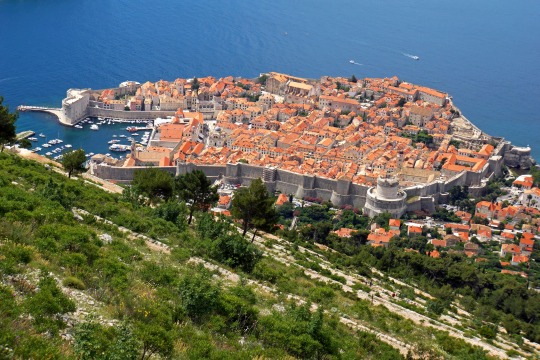



#dracula#the historian#elizabeth kostova#vampire#reading the historian#dracula daily#dubrovnik#vampire literature#ragusa#dark academia
3 notes
·
View notes
Text
The Historian, Chapter 2
So, the Carpathians. That's always been a mystical spot for historians. One of Occam's students traveled there - by donkey, I suppose - and produced out of his experiences a funny little thing called Philosophie of the Aweful. Of course, the basic story of Dracula has been hashed over many times and doesn't yield much to exploration.
Spoilers below the cut.
Summary: N’s father tells her how he, when he was a graduate student in USA, found the book with the dragon on his table at the university library. The book intrigues him, and when he notices the name Drakulya on a banner in the dragon’s claws, he immediately recognizes it both as a name for the Wallachian ruler Vlad Ţepeş in the 15th century, as well as the more well-known movie monster. He even does a little research into the history of Vlad Ţepeş, and, later, he brings the book to his adviser, the brilliant professor Rossi. To his surprise he finds that Rossi too found a book with the dragon print among his books back when he was a graduate student. This book looks different, but the print is identical. Rossi is very concerned, reveals that he too was driven to research Vlad Ţepeş, and then reveals that he has found out he is still alive.
At this point N’s father abruptly stops, and despite N’s urging he refuses to continue during this trip. When they leave the teahouse, he is very agitated and seems to look for something, but N can’t see anything. N soon learns that her father’s story only comes in short bursts. She starts to wonder if that is because he needs to protect something, his strength perhaps, or even his own sanity.
My musings: In this chapter we learn that N’s father is called Paul, and that he must have been born in 1928. As of now I can't recall if we ever learn the exact year his story takes place in, we at least know it must be in the 1950s. Graduate students in the USA seem to be around 22 to 28 years old, narrowing it down to 1950-56. And as N, 16 years old in 1972, must have been born in 1956, so I think it’s safe to narrow it down even further, to 1950-55.
I had forgotten that the reveal of Vlad Ţepeş continued existence comes this early in the book. Somehow I always feel it comes much later.
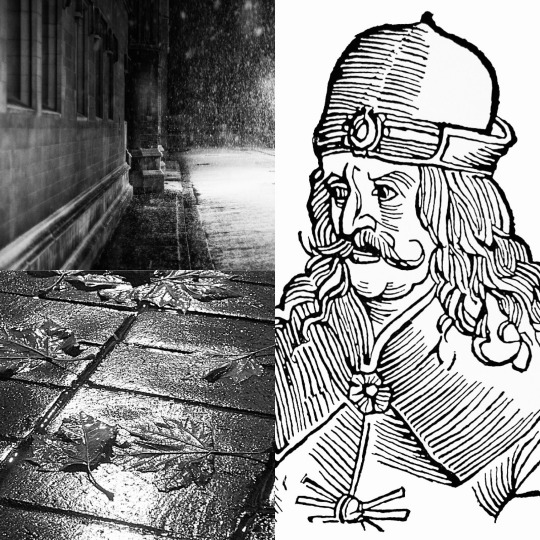
#dracula#the historian#elizabeth kostova#vampire#reading the historian#vampires#vampire literature#vlad the impaler#vlad tepes#dracula daily#dark academia
2 notes
·
View notes
Text
At a table near the window we drank tea with lemon, scalding through the thick cups, and ate our way through sardines on buttered white bread and even a few slices of torta.
I confess, I love reading about meals in the books I like. A love that started as a child, reading The Lion the Witch and the Wardrobe for the first time, which contains both Edmund’s enchanted treat given to him by the White Witch, and, much more alluringly, the tea in front of a cozy fireplace that Mr. Tumnus serves Lucy.
Personally I'm skeptical about sardines on bread, but sitting in an Art Nouveau tea house while it rains outside, drinking hot tea, sounds lovely. Especially while having a piece of torta. But what kind? Torta in itself isn’t a specific recipe, the word simply means cake. So I did a little research on cakes popular in Slovenia, and found a number of delicious sounding ones. And then I looked a bit further, and realized some of them were quite unlikely to be eaten by N and her father, on an ordinary day. Torta Ljubljana is a chocolate cake that sounds delicious, but wasn’t actually created until 2012. Potica and Torta Plava Laguna make my mouth water, but they are cakes for holidays and special events.
I have settled on either some kind of Gibanica cake, a multi layered cake with cottage cheese and egg, that can be either savory or sweet. I have already decided that I’m going to try to make Prleška gibanica, which has a filling where the farmer’s cheese and egg get additional yumminess from sugar, sourcream and butter. But they might also have had a piece of Kremna rezina (Bled Cream Cake) with a filling of vanilla custard and whipped cream.
What do you think they would have chosen?
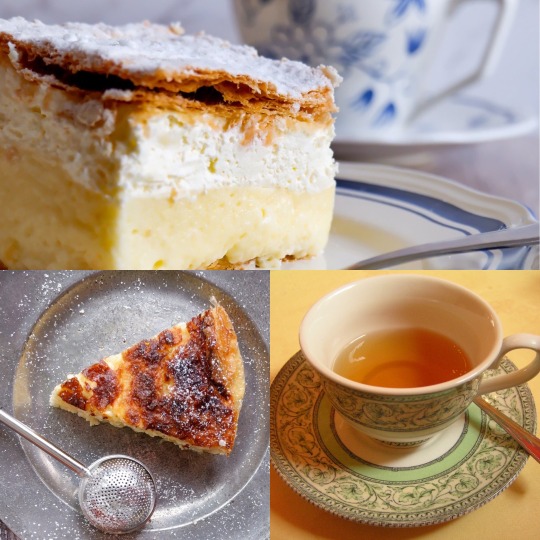
#the historian#reading the historian#elizabeth kostova#dracula daily#dracula#cake#tea#literary meals#eating in books
5 notes
·
View notes
Text
The Historian: Part One, Chapter 1.
A little housekeeping. The Historian has several narrators, all, but the teenaged narrator in the 1972 parts, are named. So for ease, I will call her N, instead of the nameless narrator. Also, these posts will contain spoilers.
Summary:
How these papers have been placed in sequence will be made manifest in the reading of them. All needless matters have been eliminated, so that a history almost at variance with the possibilities of later-day belief may stand forth as simple fact. There is throughout no statement of past things wherein memory may err, for all the records chosen are exactly contemporary, given from the standpoints and within the range of knowledge of those who made them.
Part One starts with this quote from Dracula, by Bram Stoker. It reinforces the idea that The Historian is a true account, a collection of papers that tells a story that has really happened.
In chapter 1 we learn a bit about N. She's 16 and lives with her diplomat father in Amsterdam. Her mother died as a baby, and she lives a very sheltered life, mostly occupied with her studies. At this point N thinks her father’s effort to shield her is because he is her only parent. But the reader may wonder if it’s not to protect her from something. One day she finds a book, and collection of letters in her father’s library. N doesn’t tell us what she finds in the book that captivates her, and she only reads a little from the first letter before she puts it away, but it’s a rather sinister paragraph:
My dear and unfortunate successor:
It is with regret that I imagine you, whoever you are, reading the account I must put down here. The regret is partly for myself – because I will surely be at least in trouble, maybe dead, or perhaps worse, if this is in your hands. But my regret is also for you, my yet-unknown friend, because only by someone who needs such vile information will this letter someday be read. If you are not my successor in some other sense, you will soon be my heir – and I feel sorrow at bequeathing to another human being my own, perhaps unbelievable, experience of evil. Why I myself inherited it I don’t know, but I hope to discover that fact, eventually – perhaps in the course of writing to you or perhaps in the course of further events…
Instead of asking her father about her find at once, N begs to follow him on his next diplomatic journey, something she has so far never been allowed to. He agrees, and she accompanies him to a Yugoslavian city she calls Emona. Well there, N tells her father what she has found, and now it is revealed that the book contained the printed image of a dragon, and she asks him to tell her about it, which he reluctantly agrees to do.
The real name of Emona is Ljublana, which today is the capital of Slovenia. N points out this is where the story starts, but up until this re-read I could never understand why Kostova chose this particular place. Not until this time, did I notice that N and her father cross a bridge, guarded by bronze dragons. The Dragon Bridge, Zmajski most, was built in 1901, and as you can see from the picture, the dragons are impressive. By walking over it, N truly walks into the start of this story, where the motif of the dragon will return again, and again. Ljubljana also has a dragon on the city’s coat of arms, referring to a legend that this is the place where the Greek hero Jason slayed the dragon. Or, possibly, it’s about the legend of St. George and the dragon. Either way, Ljubljana is a city of dragons, and I find it very fitting to start a book about Dracula here.


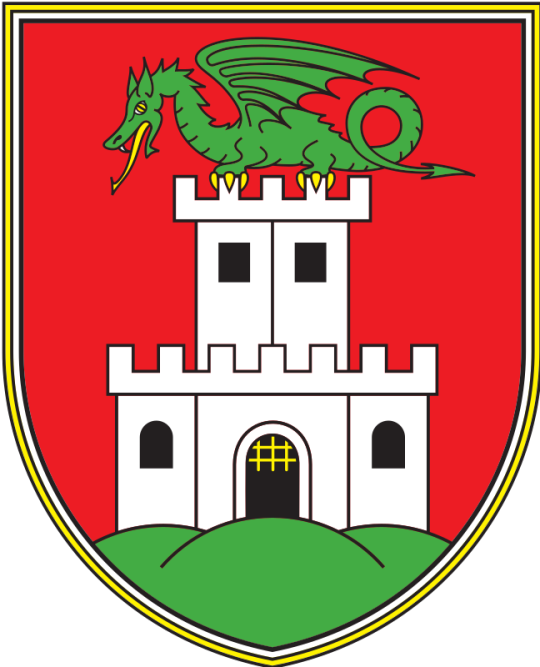
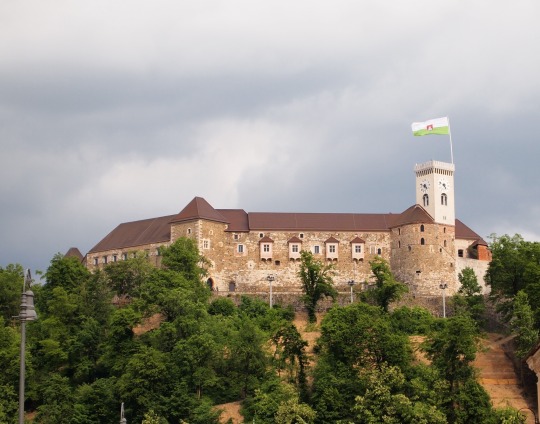
#the historian#reading the historian#elizabeth kostova#dracula#dracula daily#vampire#vampires#vampire literature#vlad tepes#vlad the impaler#dragon art#dragon bridge#amsterdam#ljubljana#dark academia
4 notes
·
View notes
Text
This little corner of tumblr has always been a bit all over, as I didn’t really have a plan for it. This has, at least temporarily, changed. For the foreseeable future I’m doing a deep-read of Elizabeth Kostova’s novel The Historian. Every Monday I will post an analysis of a chapter, and in between there will be posts relevant to the book, like fashion, geography and food.
You are all more than welcome to join in on the discussion, and sharing posts! All my Historian posts will be tagged #reading the historian.

#reading the historian#the historian#elizabeth kostova#dracula#vampire literature#vampires#vampire#vlad tepes#vlad the impaler#dracula daily#old books#dark academia
5 notes
·
View notes
Text
Map over Europe, after WWII.
As so much of The Historian takes place in the 1950- and 70s, it may be interesting with a map of how Europe looked then. Germany was split into West and East Germany. Many countries, like the Baltic states and Ukraine, were parts of the Soviet Union. Yugoslavia is today the countries Croatia, Slovenia, Macedonia and Bosnia and Herzegovina. Czechoslovakia is now the Czech Republic and the Slovak Republic.
During the Cold War, the Iron Curtain effectively split west and east Europe from each other. The countries behind the Iron Curtain were the Soviet Union, Albania, Poland, East Germany, Czechoslovakia, Hungary, Romania and Bulgaria. To travel into these countries from west Europe was possible , if a bureaucratic hassle. To travel from east to west was, depending on the country, difficult to near impossible. As we will see, this has bearings to what happens in The Historian.
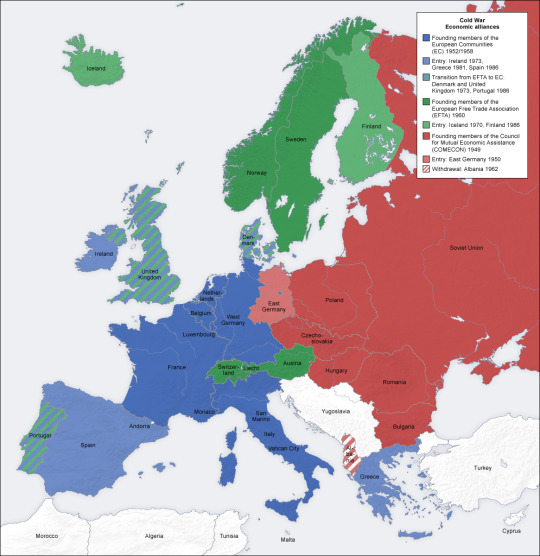
#the historian#dracula#reading the historian#elizabeth kostova#vampire literature#vampires#vampire#vlad tepes#vlad the impaler#europe#maps#dracula daily
3 notes
·
View notes
Text
Teenage fashion, 1972.
As the first chapters of The Historian takes place in the early 70s and the unnamed narrator is 16, I thought it could be fun to have a bit of a visual to what she could have worn.

#reading the historian#the historian#elizabeth kostova#1970s fashion#1970s#dracula#vampire literature#vampire#vlad tepes#vlad the impaler#dracula daily
13 notes
·
View notes
Text

The Historian: A Note to the Reader
This is not a real chapter, but merely a foreword that establishes a few things. It tells us that the voice of this story is female, that she is re-telling what happened to her 36 years earlier, when she was a young girl. So we know the narrator is middle-aged. We also learn that she works in the academic field, and that she is probably single and childless; of all the people she mentions, none are family. She also names herself a historian, and it’s very easy to assume she is the historian that the title of the book alludes to.
Most of this foreword establishes that this is a text carefully created from sources. It’s meant to be academic, verifiable. Real. But there is also a sinister thread winding through it, a warning that when searching for history,it may reach forward, and it may cause harm.
It ends with a hope a reader would see this book for the cri de coeur* it is, and then it gives a place and a date. Oxford, England, January 15, 2008.
And, by complete coincidence, I started this re-read on January 15.
*According to Merriam-Webster, a cri de coeur is ”a passionate outcry (as of appeal or protest)”
Part 1
#the historian#elizabeth kostova#dracula#vampires#vampire#vampire literature#vlad the impaler#vlad tepes#reading the historian#dracula book#books#old books#dark academia#dracula daily
5 notes
·
View notes
Text
A much better plot summary than my lame attempt!
Hey, to everyone out there who’s enjoying Dracula Daily, I would like to heartily recommend The Historian by Elizabeth Kostova, the best vampire novel since the original (possibly better than the original!).
It is a novel of Dracula - a truly menacing, horrifying Dracula. In an echo of the way Dracula is told via documents - letters, diaries, etc - The Historian also relies heavily on them, from letters to journals to family stories to centuries-old historical documents. It’s told in a nested style through three narrators, all of whom are historians - a young woman in the 1970s, her father in the 1950s, and his thesis advisor in the 1930s - with the letters/diaries/stories of the earlier narrators being experienced by the later ones. In this way, it’s told across three different eras of Europe and gets into all the real historical complexities and context of those periods, such as the Cold-War-era difficulties and dangers of carrying out travel and investigations in eastern Europe. It also draws in vampire mythos from a wider range of places than the original, including a truly fascinating stint in Istanbul.
It moves continually back and forth throughout the three narrators and time periods in a really delightful way, and all of the characters are powerfully engaging. On top of this, it can be a genuinely frightening and chilling read at some points - it’s captured the art of eerie, building horror without gore or cheap scares.
If you like history, or Dracula, and especially if you like both, you are going to love this book.
359 notes
·
View notes
Text
Understated is so much better!
hey while i'm in my vampire state of mind, please consider reading Elizabeth Kostova's novel The Historian. May I introduce it as I first met it:
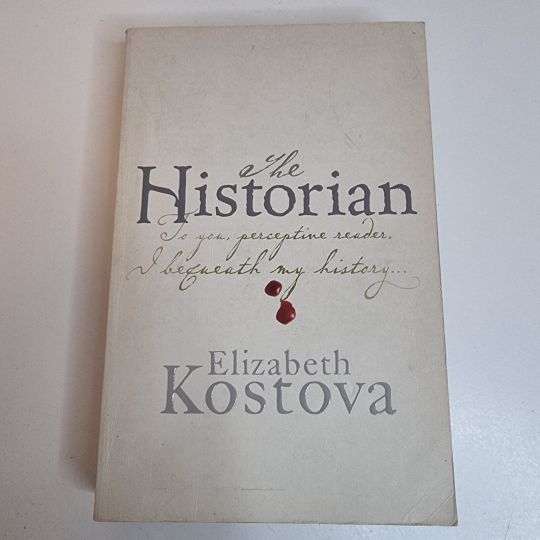
... or near enough. The copy I had was almost entirely white, the lettering merely standing out on the cardboard, no embellishment whatsoever. Or at least that's how I remember it. It was so... nondescript.
I was a bookish teen when I came across this book, and its pale cover and sparse description enticed me. It felt good and weighty in my hands. It promised secrets and mystery. I didn't realise anything was up, for a bit, until a date caught my attention: it was from a panel discussion from... a few years in the future? Surely the date was a typo. I kept going.
Letters. Journal entries. Newspaper clippings. Phone call transcripts. I was about a quarter of the way in before they dropped the name Dracula, and HOLY SHIT suddenly everything made sense. Suddenly the casual records (out of order, missing and replaced later OR recreated from memory) made sense, and the casual background white noise of fear became Front And Centre Terror as I realised who was the focus of the story.
"Child... where is your father?" FUCK. I had NIGHTMARES from that line alone.
I loved it. I kept it overdue from the library and no-one cared, no-one requested it. It's like they didn't realise the gold they had here, in this simple white cover.
A few years later I was out and about, and I saw a copy in a bookstore where someone had decided subtlety was out of style and they slapped THIS GUY on the cover.
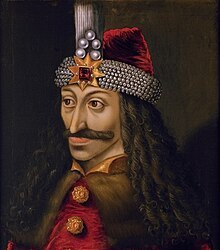
Sure. Okay.
They have since re-released with a more understated cover...
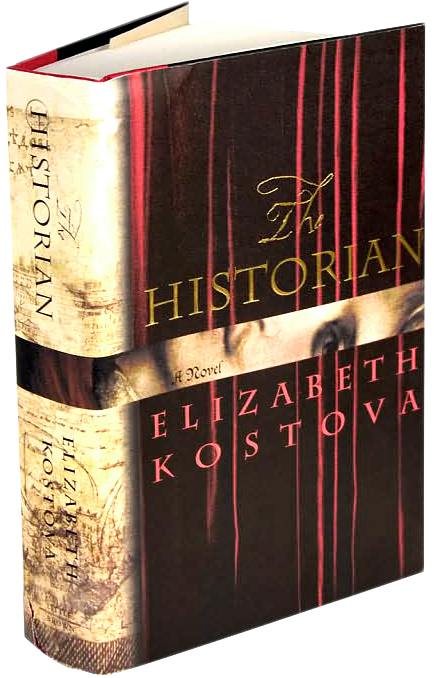
... though I miss the white cardboard and the simplicity, the way the story itself was a shock and surprise. Any fans of Dracula are going to love this one. Please enjoy.
45 notes
·
View notes
Text

About once a year I feel the urge to re-read The Historian by Elizabeth Kostova. It’s one of my favorite books, and I have the idea to do more of a deep read of it. Anyone wants to join in. I’m planning to drop a chapter every Monday, starting with the Prologue on January 15.
In 1972 the teenage protagonist is living with her American diplomat father in Amsterdam.She has no memories of her mother, and is, on the whole, quite content with her life. But one day her father disappears, and while she goes looking for him, she also starts to learn how he, with a young woman called Helen, made a similar quest after his tutor, in the 1950s. And slowly, both the protagonist, and the younger version of her father, realizes that they are also hunting for Dracula.
The book is some 700 pages, and takes place in several countries, and during three timelines. It’s also pretty slow-moving at places. Personally I love all this. It also entwines the literary Dracula with the real Vlad Tepes, another thing I always enjoy.
My own interest in vampires, as well as the historical Dracula, was kick-started by a documentary called In Search of Dracula, narrated by Christopher Lee. He also plays both versions of Dracula. If you want to have a little more background before reading The Historian, this documentary is a good place to start.
<iframe width="560" height="315" src="https://www.youtube.com/embed/pC_9GJv3a0g?si=AwuWKyj_i7qHpmBD" title="YouTube video player" frameborder="0" allow="accelerometer; autoplay; clipboard-write; encrypted-media; gyroscope; picture-in-picture; web-share" allowfullscreen></iframe>
youtube
#the historian#elizabeth kostova#dracula#vampire#vampires#vampire literature#christopher lee#in search of dracula#reading the historian#vlad the impaler#vlad tepes#Youtube#dracula daily#dark academia
5 notes
·
View notes